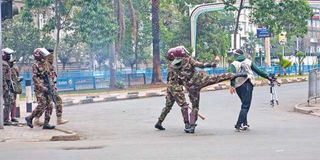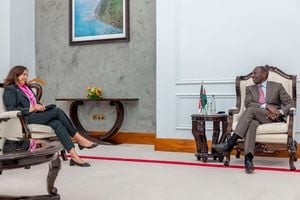
After all the hype about a mega ‘Nane Nane’ protest that would have a million people march to State House and evict President William Ruto, the scattered Gen Z protests on Thursday, August 8, might be seen as a damp squib.
There were scattered demonstrations in Nairobi’s Central Business District and outlying urban areas that were easily broken up by the heavy police presence. Very little was reported from Mombasa, Kisumu, Nakuru, Eldoret, Nyeri and other towns that recorded significant protests in previous editions of the youthled revolt.
As the first Gen Z protests since President Ruto’s ‘handshake’ with opposition leader Raila Odinga and incorporation of the latter’s surrogates into the reconstituted Cabinet, there will be discussion on the impact of that dramatic political development.
The relative quiet in Kisumu, Raila’s bastion, and Mombasa, another key stronghold of his ODM party, may well reflect dividends of the new political alliance, which generally makes the main opposition part of government.

Addressing a press conference in Nairobi on Thursday evening, acting Inspector-General of Police Gilbert Masengeli said the protests recorded low turnouts across the country.
“Today, the country remained peaceful and normalcy prevailed, except in Nairobi where one officer was injured,” he said. According to the police boss, “Minimal skirmishes” occurred in downtown Nairobi, as well as Kisii and Migori towns, where he planned disturbances were thwarted by security forces.
In total, he said, there were 174 arrests, of which 126 were in Nairobi, 22 in Kitengela, just south of the capital city in Kajiado County, and 26 at Emali along the Nairobi-Mombasa highway in Makueni County. The significant number of arrests, however, reveals that the country was not as placid as the government would want to portray.

Police Officers arrest a protester during Nane Nane protests along Kimathi Street in Nairobi on August 8, 2024.
The fact is that even without anything resembling the massive gatherings recorded in previous protests since the Gen Z revolt against high taxation – which then morphed into a ‘Ruto Must Go’ campaign – was launched in June, business in Nairobi city centre and on all routes leading into the city was brought to a virtual standstill.
Other than the threat to march to State House and eject Ruto, a wildly ambitious target, a more attainable goal of protest organisers was to shut down the city.
In that, it seems the police inadvertently aided the protesters by setting up roadblocks on all roads leading into Nairobi, and generally barring access into town.
The aim was to prevent protesters making their way into the city centre, but the net effect was that even those who needed to go into town to work, open their businesses or attend to other matters were prevented from doing so.
According to activist Wanjira Wanjiru, one of the main faces and voices of the youthful protest movement, the fact that not as many of her comrades as hoped made it to town was not an indication of failure.
In her view, ‘Nane Nane’ was a success because there was no business activity in the city centre the entire day. “Even if we didn’t achieve our mission of removing Ruto,” she said, “we still continue to show that there is active resistance still, there is resilience … we are still showing the world why Ruto just go.”
Wanjira, who runs the Mathare Social Justice Centre, says the situation would have been very different had the police not effectively blockaded the city, preventing entry to nearly everybody.
She, however, concedes that the ‘tribeless, partyless, leaderless’ movement, which has caught global attention and inspired youth revolts in other parts of world, must discuss new strategies.
She would prefer more frequent and more sustained protests, and also concedes that while the movement has grown organically without a centralised command, there may now be need for formal structures to ensure a better organisation.
“The struggle continues,” she signs off, shortly after leaving Nairobi’s Central Police Station to check on arrested protesters.
The ‘Nane Nane’ protests came on the same day as President Ruto witnessed the swearing-in of the new Cabinet, which includes four top ODM leaders, including deputy party leaders Wycliffe Oparanya (Cooperatives and SMEs) and Hassan Joho (Mining and the Blue Economy), National Chairman John Mbadi (National Treasury) and National As-sembly Minority Leader (Energy and Petroleum).
However, what made the bigger news was the police siege at the residence of controversial businessman and politician Jimmy Wanjigi, whom they accused of ferrying protesters to town and dishing out cash.
The police boss also claimed that they had recovered tear gas canisters from a car reportedly used by Wanjigi while making his escape from pursuing officers.
However, according to some reports, Wanjigi claimed that it was the police who planted the canisters as they searched the car, which was left outside his gate. It was searched by police and then towed away.
A large squad of heavily armed officers, some in anti-riot body armour and others in the type of outfits worn by special forces, bad camped outside the locked gate for hours, until Masengeli appealed to Wanjigi, who in the past has been a key ally and political strategist for Raila, appealed to him to surrender at the nearest police station.
Later in the night, CCTV footage emerged showing dozens of police officers entering the residence is style not unlike a mission against terrorists. It was unclear at the time whether Wanjigi was in the house.
‘Nane Nane’ also happened to come just a day after the United States government cautioned Ruto that it was keeping a close eye on police excesses in the crackdown on Gen Z protests.

President William Ruto with US Under Secretary of State for Civilian Security, Democracy and Human Rights Uzra Zeya at State House Nairob, Kenya.
Visiting Under-Secretary for Civilian Security, Democracy, and Human Rights, Uzra Zeya, met Ruto at State House, where she raised concerns on erosion of civil liberties, curtailment of constitutional, rights of assembly and expression, attacks against journalists, police brutality and reported abductions and disappearances of government critics.
Reinforcing a message delivered on phone last month by Secretary of State Anthony Blinken, Zeya also made a point of visiting Director of Criminal Investigations Mohammed Amin, who is directly responsible for the special police squad that has gained notoriety for violent abductions in the course of investigating suspect protest organisers.
Those abducted are never booked into police or brought to court, but driven to secret locations and aggressively interrogated without the presence of their lawyers.
They are then abandoned in distant places. However, whereabouts of some remain unknown weeks after their abductions, with a number having been found dead.
The Independent Police Oversight Authority, the civilian agency responsible for investigating police misdeeds, has expressed frustration that Amin is sabotaging their efforts to bring the offending officers to justice.
Former Inspector-General of Police Japheth Koome, who resigned a month ago, had publicly instructed officers not to cooperate with IPOA or any other agency investigating crimes allegedly committed by their compatriots.
Masengeli has not rescinded the irregular order, which apparently also had the support of Interior Cabinet Secretary Kithure Kindiki, one of the CSs’ returned to their old positions when Ruto named his new Cabinet, a month after sacking the entire lot in response to the Gen Z protests.
The President has also refused to acknowledge police excesses in numerous statements since the Gen Z protests were launched in June, instead using every opportunity to laud the service for its good work in suppressing the youth revolt.
But how exactly was the Gen Z movement humbled? Two strategies are discernible. One, all genres of violence were used to prevent the youth from peacefully assembling, including the use of non-uniformed armed officers, infiltration of their movement by hired goons, abductions and killings.
As a result, more than 55 protesters have died and many more abducted since the demonstrations started in June, according to the state-funded Kenya National Commission on Human Rights. Two, to bring the Gen Z to heel, Kenya and its partners in the West appears to have resorted to the well-known ‘Opposition Strategy.
The West’s opposition strategy first appeared in the African Report by the International Crisis Group (ICG) titled: Zimbabwe: An Opposition Strategy, (N°117, August 24, 2006). The script of this strategy was tried in Zimbabwe and Kenya in 2008. One of the elements of the strategy the creates and supports an opposition leader often with a larger-than-life persona — exemplified by two friends, Raila Odinga in Kenya and Morgan Tsvangirai in Zimbabwe. The second strand is to unify the opposition and civil society to form a super opposition movement with huge political capacity.
Third is to push the government to share power with the opposition in a transitional government, giving western actors the control the levers of policy-making in the government. In a word, the “Opposition Strategy” ensures that both the opposition and the government are safe for the West. It is a perfect neo-colonial tool. The Gen Z movement challenged the West’s opposition strategy. It has, therefore, been seen as a potential cause of instability and an existential threat to Western interests.
The Gen Z movement registered quick victories in June. President Ruto withdrew the contentious Finance Bill 2024; sacked his entire cabinet and promised to form a new “broadbased” Government.
Former Inspector General of Police, Japhet Koome, resigned after being widely accused of extreme brutality against peaceful protesters. But these gains were quickly rolled back. Dr. Ruto reappointed six CSs in the old cabinet and gave four posts to the opposition, including the powerful finance and energy ministries.
Paradoxically, while anger over the new cabinet appointments were part of the reason for the Nane Nane protests, the broad-based government succeeded in confining the protests to Nairobi and its environs.
Major towns and cities such as Kisumu (Raila’s hometown), Eldoret (Ruto's city) and Mombasa (home of newly appointed opposition CSs, Ali Joho and Opiyo Wandayi) that previously witnessed protests remained calm. This enabled the government to mobilise enough police officers, to contain protests in the Capital City.
Although Nane Nane protests organisers hoped to bring five million Kenyans into the capital, the use of tear gas, mounting roadblocks on major roads and to disperse protesters and mass arrests barred protesters from accessing the central business district.
Heavy security was deployed at State House where the new cabinet was sworn in and protesters had threatened to storm.
The onus is now on the government to address the issues raised by the youth. So far, Kenya is a perfect dialogue of the deaf. The government is focused on its détente with the Raila wing of the opposition as an “alliance of rivals.”
But Kenya’s young protesters have dismissed the new cabinet as merely perpetuating deal-making among the political elite, ignoring serious governance issues they have raised.
Kenya is no longer at ease. Its young people have vowed to continue demonstrating for the justice of those killed or abducted and “until the president steps down”.
In the corridors of diplomacy, on August 8, the United States warned that it will not accept any further abductions and killing of innocent protestors, calling for immediate action against human rights violations. For now the dreams of the Kenyan youth may have been deferred, but not for too long.







